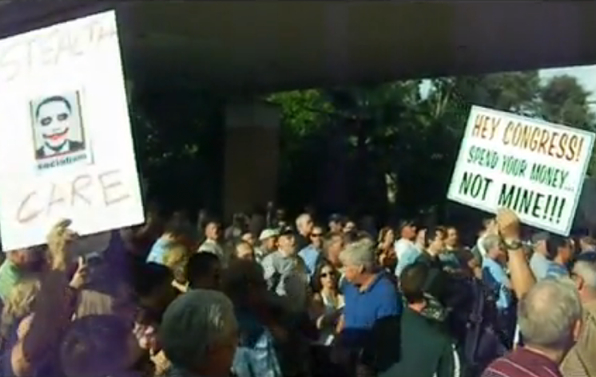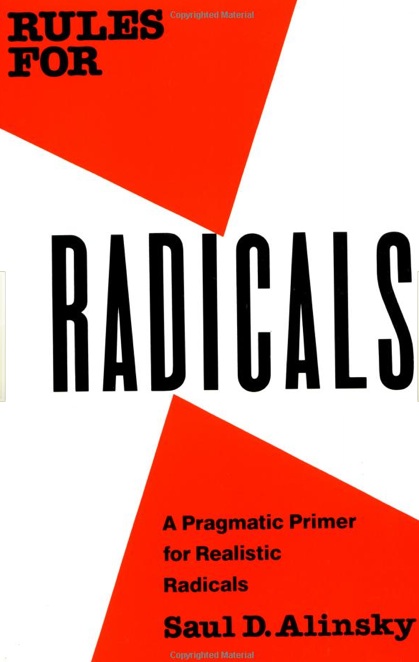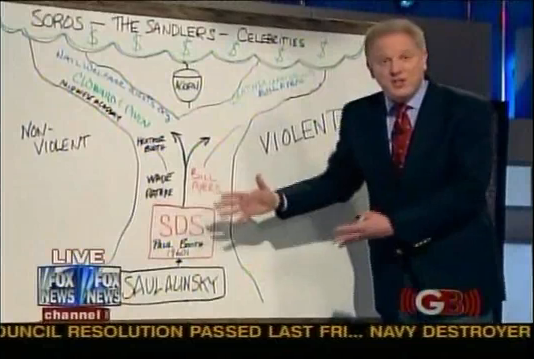Conservatives Find Town Hall Strategy in Leftist Text
Thirty-seven years after his death, community organizer Saul Alinsky has a surprising new fan base.
Jul 31, 20206K Shares150.9K Views
Protesters outside a health care town hall meeting held by Rep. Kathy Castor (D-Fla.) in Tampa last Thursday (YouTube)
Michael Patrick Leahy’s self-published conservative manifesto is coming off the presses this week, and not a moment too soon.
“The timing is crucial,” said Leahy, the Nashville, Tenn., activist who founded the Top Conservatives on Twitter hashtag and played another founding role in the anti-tax “Tea Party” movement. “I’m trying to get these principles out there for conservatives this month, as people attend these town hall meetings with their members of Congress. These are principles that conservatives need to know.”
Image by: Matt Mahurin
Those principles are the ones that the late left-wing activist Saul Alinsky outlined in his 1971 book “Rules for Radicals: A Pragmatic Primer for Realistic Radicals.” Leahy’s book, “Rules for Conservative Radicals,” boils them down and scraps Alinsky’s more “amoral” suggestions. “The problem that conservatives have with Alinsky is that, for him, the ends justified the means,” explained Leahy. “I’m suggesting that we take the successful Alinsky rules, we update them and apply them to new social networking technology, and we execute them in the Judeo-Christian tradition.”
Thirty-eight years since the publication of his handbook and 37 years since he died, Alinsky has found a thriving and surprising fan club in the modern conservative movement. Leahy is one of many “Tea Party” activists who have latched onto “Rules for Radicals” as a blueprint for a counter-revolution, a campaign of robust challenges to President Barack Obama and the Democratic Congress that is playing out nearly every day of the August recess in noisy town hall meetings. “Alinsky-cons” have taken the union organizer’s “13 rules for power tactics” and “11 rules to test whether power tactics are ethical” and found a strategy that, they believe, is chipping away at the momentum for national health care reform. When they flummox representatives with chants, or laugh out loud at their attempts to explain their votes, many “Tea Party” activists say they’re cribbing from Alinsky.
The most obvious beneficiary of the surge of interest in Alinsky has been Random House, which publishes the book through its Vintage imprint. According to Nielsen BookScan, “Rules for Radicals” has sold 15,000 copies since the start of this year — it only sold 35,000 copies from 2000 through 2008. Since the start of August, it has sold 1,000 copies. At Amazon.com, “Rules” is safely nestled in the Top 75 on the retailer’s bestseller list, and it’s No. 1 in the “radical thought,” “civics,” and “sociology/history” categories. Most tellingly, the people who snatch up copies of Alinsky’s book at Amazon don’t go on to buy more liberal texts. Instead, according to the online bookseller, they purchase Michelle Malkin’s “Culture of Corruption,” Glenn Beck’s “Common Sense,” and Mark Levin’s “Liberty and Tyranny.”
“I picked up the book after the [November 2008] election,” said John O’Hara, a staffer at the conservative Heartland Institute who helped plan anti-tax “Tea Parties” in February and April. “There really is no equivalent book for conservatives. There’s no ‘Rules for Counter-Radicals.’”
Amazon.com
There’s a reason why “Rules for Radicals” became the go-to book for would-be Tea Party and town hall activists. Alinsky-cons can trace their inspiration back to 2008, when it became clear that Obama would win the nomination and Republicans looked deeper into his past for clues about his hidden, not-so-centrist beliefs. Attacking Alinsky was easy; Secretary of State Hillary Rodham Clinton had been pilloried for writing her senior thesis on the organizer, and in his influential 2008 book “Liberal Fascism,” Jonah Goldberg placed him firmly in the totalitarian tradition: “substitute the word ‘fascist’ for ‘radical’ in many of Alinsky’s statements and it’s sometimes difficult to tell the difference.” In the conservative muckraker Jerome Corsi’s “Obama Nation,” published one year ago this week, Alinsky (whom Obama never met) was singled out as a malign influence in the candidate’s education. Alinsky had “
The attack traveled slowly from Corsi’s bestseller and conservative Websites into Republican talking points. In the final month of the presidential race, when Sen. John McCain’s campaign attacked Obama for befriending reformed Weather Underground terrorist Bill Ayers and receiving campaign help from the community organizing group ACORN, Alinsky became the hidden influence in Obama’s career, in the eyes of many Republicans. In an Oct. 7, 2008 interview on MSNBC’s “Morning Joe,” former New York Mayor Rudy Giuliani noted, darkly, that the Democratic presidential candidate had been “educated in the Saul Alinsky methods.” In her infamous Oct. 17, 2008 interview on “Hardball,” which generated a backlash that nearly cost her a seat in Congress, Rep. Michele Bachmann (R-Minn.) accused Obama of hobnobbing with “radical leftists” and called Alinsky
Obama hadn’t exactly covered his tracks. The candidate had written and spoken extensively about his past as a community organizer; Obama’s old allies had spoken about itin a sympathetic profile piece by Ryan Lizza, published in The New Republic. Still, the idea of Alinsky and “Rules for Radicals” as a skeleton key explaining how Obama rose to power, or why Organizing for America was created after the campaign ended, has proven incredibly powerful. On his Fox News show, Glenn Beck has put up chartsthat connect Alinsky to ACORN and Obama’s allies. When Rush Limbaugh came under fire for hoping the president would “fail,” he told Mark Levinthat he was being “Alinskyed.”
Glenn Beck illustrates Alinsky's influence on the left. (Fox News)
The growth of the “Tea Party” movement has seen Alinky morph from a bogeyman to a possible inspiration to conservative activists. In April, Brendan Steinhauser of FreedomWorks, the conservative group that has provided guidance to many “Tea Party” organizers and town hall rowdies, told TWIthat the group was “applying Saul Alinsky’s ‘Rules for Radicals’” in its approach to anti-tax “Tea Parties.” In June, he told Eric Kleefeld of TPMDCthat “Rules” was the first book handed to new employees of the group.
“That first rule, ‘power is not only what you have, but what an opponent thinks you have’ — that argument is happening right now,” said Steinhauser, “with both sides arguing about which side represents the majority on health care.” The mockery and laughter at town halls struck Steinhauser as an adoption of the fifth rule, which posits that “Ridicule is a man’s most potent weapon.” The old deference to congressmen, out of respect for the office, has “broken down.”
Other “Tea Party” activists have gotten on board; a memo written by Bob MacGuffieof the conservative group Right Principles told conservatives to adopt some of the “Rules” at town hall meetings and hold their representatives to account. “Use the Alinsky playbook of which the left is so fond,” wrote MacGuffie, quoting from the twelfth of Alinsky’s original rules. “Freeze it, attack it, personalize it, and polarize it.”
Some conservative writers have latched onto “Rules for Radicals” to explain the extremist roots of a new Obama policy or explain why a new anti-Obama tactic will work. National Review’s Andrew McCarthy has warnedthat the Obama administration might “cook the books” on the 2010 Census because it “apportions political count,” and “anyone who has read Alinsky could have predicted that the census would be among Obama’s top priorities.” Joseph Farah, the editor-in-chief of the conservative Website WorldNetDaily, has theorizedthat the Obama administration mocks “birthers” who push conspiracy theories about the president’s citizenship because it’s following Alinsky’s fifth rule on “ridicule.”
All of this has been quite confusing to Gregory Galluzzo. A veteran community organizer at the Gamaliel Foundation and a disciple of Alinsky (though they never met) who trained the young Obama, Galluzzo has watched with frustration as “over the top and rabid ideologues” on the right stormed town hall meetings, claiming to have flipped Alinsky’s rulebook back onto liberals.
“They polarize,” said Galluzzo. “They’ve got that part down. They do direct action. But that’s not the kind of organizing we do. We end up building relationships with the people we oppose. I’m not going to go up to Mayor [Richard] Daley and say ‘you’re just a Nazi.’ I want to end up working with him.”
But according to Galluzzo, if Alinsky could take a look at the Alinsky-cons, he’d call them “petty protesters” who want to destroy the system without offering solutions. “If you just go around calling people assholes,” Galluzzo said, “you’re not going to get anything done.”
–

Paula M. Graham
Reviewer
Latest Articles
Popular Articles



